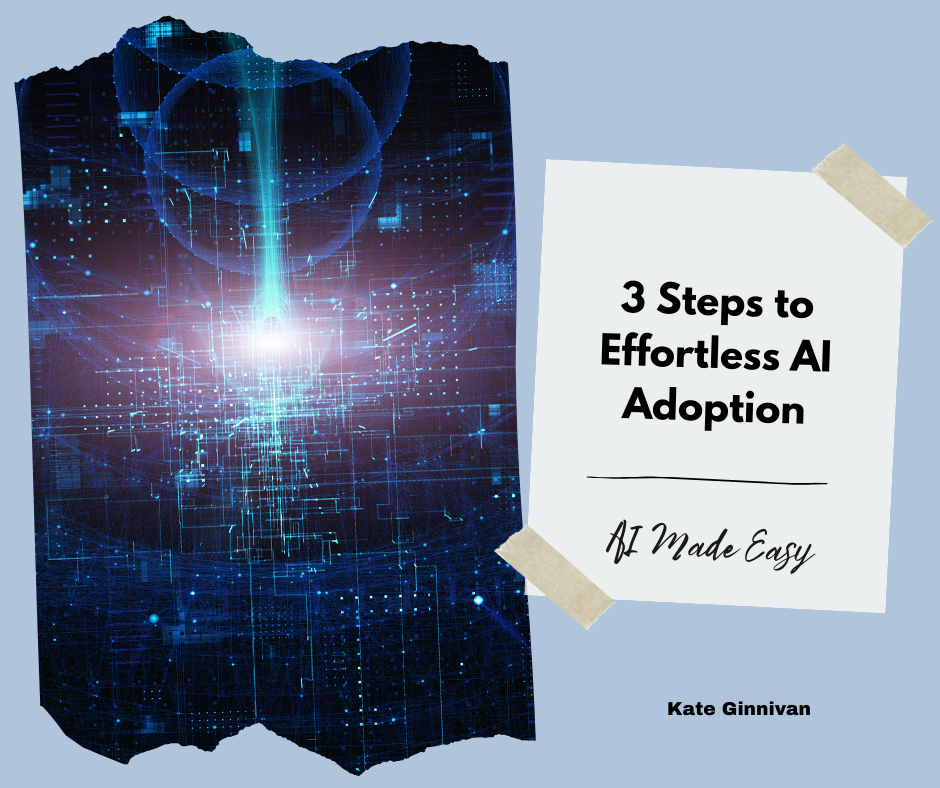
Artificial Intelligence is no longer a distant sci-fi dream; it’s an urgent necessity.
Every industry faces a pivotal moment where embracing AI is not just an option, but a requirement for staying relevant, competitive and future-proof.
This rings especially true for service-based businesses, where AI’s potential to enhance efficiency and accuracy is PHENOMENAL.
Yet, many are still on the fence, unsure of how to approach this transformation.
Today we’re going to demystify AI adoption in three straightforward steps, promising not just an upgrade to your practice but a leap into the future.
You’ll discover the essentials of effortless AI integration, and learn why mastering this technology is not just beneficial, but vital for your business’ longevity AND success.
Ready? Let’s dive in.
STEP #1: Understanding AI and Its Relevance to Your Practice
AI is the key to unlocking your practice’s full potential.
Artificial Intelligence and Natural Language Processing (NLP) models aren’t about robots or complex algorithms; they’re about smart solutions tailored to your unique professional needs.
Imagine a tool that not only understands your industry but also evolves with it.
This is what NLP platforms, like ChatGPT offer – a chance to enhance your services, streamline operations, and stay ahead in your field.
The first step is understanding the basics: what AI is, how it works, and its applications specific to your industry.
Think of AI as a tireless, uber-versatile assistant, constantly learning and adapting to provide you with the best solutions.
How can AI revolutionize your practice?
AI’s impact on professional practices is multifaceted.
It can optimize mundane tasks, analyze large datasets with incredible accuracy, and even predict future trends.
For instance, in healthcare, AI can assist in patient diagnosis and treatment planning, while in finance, it can help in fraud detection and personalized financial advice.
The question then is not if AI can enhance your services, but HOW.
Identifying the areas where AI can add the most value to your business is absolutely crucial.
To truly leverage AI, keeping abreast of the latest developments is essential. This doesn’t mean becoming a tech expert but understanding enough to see where AI fits into your practice.
Regularly exploring AI innovations pertinent to your field will help you spot opportunities for integration and improvement.
STEP #2: Planning and Preparing for Integration
Effective planning is the foundation of successful AI integration.
Without a clear plan, even the most sophisticated AI solutions can falter.
Planning involves understanding your company’s specific needs, the problems you aim to solve with AI, and setting measurable objectives. This involves aligning AI capabilities with your short and long-term goals – for revenue, reach and industry authority.
As Taylor Swift reminds us in ‘Mastermind’:
“If you fail to plan, you plan to fail
Strategy sets the scene for the tale”
In other words, failure to plan inevitably leads to failure to progress.
Research indicates that a significant portion of AI projects fail due to various factors, including lack of planning and unclear objectives. Gartner, a leading research and advisory company, predicted that up to 85% of AI projects would fail to deliver for Chief Information Officers (CIOs). This high failure rate is attributed to risks and confusion surrounding AI projects, such as the decision to replace legacy systems, lack of understanding about AI, and challenges in acquiring the right talent for AI initiatives.
In addition, Skim AI outlines several reasons contributing to the failure of enterprise AI projects. Among these reasons, unclear business objectives play a crucial role.
This is because ambiguities in project goals cause a disconnect between AI model use and business objectives, leading to project failures, resource wastage, and missed opportunities.
Consider, for example, a growing health and wellness center that implemented AI for client data analysis and appointment scheduling. This integration not only streamlined their operations but also enhanced client care. Their success lay in identifying specific areas where AI could add value and meticulously planning its integration.
The message?
Learn from those who’ve succeeded.
Establish clear project goals and desired outcomes before determining how you’ll use AI to streamline your business objectives.
STEP #3: Implementing AI with Continuous Learning & Adaptation
Implementing AI is not a one-time event, but a continuous journey.
The biggest mistake businesses make is treating AI implementation as a one-off project.
AI systems, by nature, evolve and improve over time, in the same way our use of the English language does:
👉 My Gen Z niece didn’t understand the term ‘Fly by the seat of your pants’, but was able to articulate why ‘Rizz’ deserved to be named the Oxford Dictionary word of the year, for example.
Post-implementation, continuous training and adaptation are necessary to ensure these systems remain relevant and effective.
Adaptation ensures AI grows with your business.
The beauty of AI lies in its ability to learn and adapt.
Continuous learning ensures that your AI systems evolve with your practice, consistently providing optimal solutions. This evolution is not just technological but also involves adapting your team and processes to work harmoniously with AI.
Real-world success through adaptation.
Take the example of a consultant who integrated AI into their workflow. By continuously adapting to new updates and features, they managed to streamline processes, improve efficiency, and stay ahead of the curve. This demonstrates the incredible power of embracing AI as a dynamic tool that grows and evolves in step with your confidence and capability in engaging with technology.
Embracing AI in your practice is not just about keeping up with technology; it’s about future-proofing your business, enhancing your services, and staying ahead in an increasingly competitive landscape.
With understanding, planning, and continuous adaptation, AI integration can be a smooth, transformative journey, leading to a more efficient, innovative, and successful practice.
Founder of SILVER PENNED